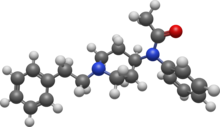Acetylfentanyl (acetyl fentanyl) is an opioid analgesic drug that is an analog of fentanyl.[4] Studies have estimated acetylfentanyl to be 15 times more potent than morphine,[5][6] which would mean that despite being somewhat weaker than fentanyl, it is nevertheless still several times stronger than pure heroin. It has never been licensed for medical use and instead has only been sold on the illicit drug market. Acetylfentanyl was discovered at the same time as fentanyl itself and had only rarely been encountered on the illicit market in the late 1980s. However, in 2013, Canadian police seized 3 kilograms of acetylfentanyl.[7] As a μ-opioid receptor agonist, acetylfentanyl may serve as a direct substitute for oxycodone, heroin or other opioids. Common side effects of fentanyl analogs are similar to those of fentanyl itself, which include itching, nausea, and potentially fatal respiratory depression. Fentanyl analogs have killed hundreds of people throughout Europe and the former Soviet republics since the most recent resurgence in use began in Estonia in the early 2000s, and novel derivatives continue to appear.[8][9][10]
 | |
 | |
| Clinical data | |
|---|---|
| Routes of administration | oral, iv, im, insuflation |
| ATC code |
|
| Legal status | |
| Legal status |
|
| Identifiers | |
| |
| CAS Number | |
| PubChem CID | |
| ChemSpider | |
| UNII | |
| KEGG | |
| CompTox Dashboard (EPA) | |
| ECHA InfoCard | 100.169.973 |
| Chemical and physical data | |
| Formula | C21H26N2O |
| Molar mass | 322.452 g·mol−1 |
| 3D model (JSmol) | |
| |
| |
Deaths
editEurope
editAcetylfentanyl has been analytically confirmed in 32 fatalities in four European member states between 2013 and August 2015, Germany (2), Poland (1), Sweden (27), and the United Kingdom (2).[3]
Russia
editTwelve deaths have been associated with acetylfentanyl in Russia since 2012.[3][11]
United States
editThe Centers for Disease Control and Prevention (CDC) issued a health alert to report that between March 2013 and May 2013, 14 overdose deaths related to injected acetylfentanyl had occurred among intravenous drug users (ages between 19 and 57 years) in Rhode Island. After confirming five overdoses in one county, including a fatality, Pennsylvania asked coroners and medical examiners across the state to screen for acetylfentanyl. As a result of this investigation, Pennsylvania confirmed at least one acetylfentanyl overdose death and attributed at least 50 fatalities to either fentanyl or acetylfentanyl during the first half of 2013.[12][13] In July 2015, the DEA informed about 52 confirmed fatalities involving acetylfentanyl in the United States between 2013 and 2015.[14]
Japan
editOne fatal poisoning caused by intravenous injection of a "bath salt" product containing acetylfentanyl mixed with 4'-Methoxy-α-pyrrolidinopentiophenone (a substituted cathinone) has been reported in 2016.[15]
Legal status
editCanada
editAs an analog of fentanyl, acetylfentanyl is a Schedule I controlled drug.[1]
China
editAs of October 2015, acetylfentanyl is a controlled substance in China.[16]
United States
editAcetylfentanyl is a Schedule I controlled substance as of May 2015.[17]
Switzerland
editAs of March 2023[update], acetylfentanyl is a controlled substance in Switzerland.[18]
United Kingdom
editAcetylfentanyl was made a class A drug as an analogue of fentanyl in 1986.[19]
Overdose
editAcetylfentanyl overdosage has been reported to closely resemble heroin overdosage clinically. Additionally, while naloxone (Narcan) is effective in treating acetylfentanyl overdose, larger than normal doses of the antidote may be required.[5]
Detection in body fluids
editAcetylfentanyl may be quantitated in blood, plasma, or urine by liquid chromatography-mass spectrometry to confirm a diagnosis of poisoning in hospitalized patients or to provide evidence in a medicolegal death investigation. Postmortem peripheral blood acetylfentanyl concentrations have been in a range of 89–945 μg/L in victims of acute overdosage.[20][21]
See also
editReferences
edit- ^ a b "Controlled Drugs and Substances Act". IsomerDesign.
- ^ "Two Charged With Witness Tampering in Joint Woonsocket Police, DEA Investigation". The United States Attorney's Office: District of Rhode Island. US Department of Justice. 6 June 2013.
- ^ a b c European Monitoring Centre for Drugs Drug Addiction; European Police Office (June 2016). EMCDDA–Europol Joint Report on acetylfentanyl. European Monitoring Centre for Drugs and Drug Addiction (EMCDDA). doi:10.2810/890694. ISBN 9789291689163.
- ^ Helander A, Bäckberg M, Beck O (20 April 2016). "Intoxications involving the fentanyl analogs acetylfentanyl, 4-methoxybutyrfentanyl and furanylfentanyl: results from the Swedish STRIDA project". Clinical Toxicology. 54 (4): 324–32. doi:10.3109/15563650.2016.1139715. PMID 26850293. S2CID 41668288.
- ^ a b Higashikawa Y, Suzuki S (June 2008). "Studies on 1-(2-phenethyl)-4-(N-propionylanilino)piperidine (fentanyl) and its related compounds. VI. Structure-analgesic activity relationship for fentanyl, methyl-substituted fentanyls and other analogues". Forensic Toxicology. 26 (1): 1–5. doi:10.1007/s11419-007-0039-1. ISSN 1860-8965. S2CID 22092512.
- ^ Aceto MD, Bowman ER, Harris LS, May EL (1989). "Dependence studies on new compounds in the rhesus monkey, rat and mouse (1989)" (PDF). NIDA Research Monograph. 95: 578–631. PMID 2641054. Archived from the original (PDF) on 2016-12-22. Retrieved 2016-08-26.
- ^ "Extremely potent painkiller hits Montreal black market". CBS News. 13 May 2013.
- ^ Mounteney J, Giraudon I, Denissov G, Griffiths P (July 2015). "Fentanyls: Are we missing the signs? Highly potent and on the rise in Europe". The International Journal on Drug Policy. 26 (7): 626–31. doi:10.1016/j.drugpo.2015.04.003. PMID 25976511.
- ^ Ruangyuttikarn W, Law MY, Rollins DE, Moody DE (May–June 1990). "Detection of fentanyl and its analogs by enzyme-linked immunosorbent assay". Journal of Analytical Toxicology. 14 (3): 160–4. doi:10.1093/jat/14.3.160. PMID 2374405.
- ^ Kroll D (29 August 2013). "CDC Issues Alert On Deadly New Designer Drug, Acetyl Fentanyl". Forbes.
- ^ Melent'ev AB, Kataev SS, Dvorskaya ON (February 2015). "Identification and analytical properties of acetyl fentanyl metabolites". Journal of Analytical Chemistry. 70 (2): 240–248. doi:10.1134/S1061934815020124. ISSN 1061-9348. S2CID 95218072.
- ^ Centers for Disease Control Prevention (CDC) (August 2013). "Acetyl fentanyl overdose fatalities--Rhode Island, March-May 2013". MMWR. Morbidity and Mortality Weekly Report. 62 (34): 703–4. PMC 4604997. PMID 23985500.
- ^ Lozier MJ, Boyd M, Stanley C, Ogilvie L, King E, Martin C, Lewis L (June 2015). "Acetyl Fentanyl, a Novel Fentanyl Analog, Causes 14 Overdose Deaths in Rhode Island, March-May 2013". Journal of Medical Toxicology. 11 (2): 208–17. doi:10.1007/s13181-015-0477-9. PMC 4469714. PMID 25934111.
- ^ Drug Enforcement Administration (July 2015). "Acetyl fentanyl" (PDF). Drug Enforcement Administration Office of Diversion Control.
- ^ Yonemitsu K, Sasao A, Mishima S, Ohtsu Y, Nishitani Y (October 2016). "A fatal poisoning case by intravenous injection of "bath salts" containing acetyl fentanyl and 4-methoxy PV8". Forensic Science International. 267: e6 – e9. doi:10.1016/j.forsciint.2016.08.025. PMID 27591912.
- ^ 关于印发《非药用类麻醉药品和精神药品列管办法》的通知 [Notice on Printing and Distributing the "Measures for the Scheduling of Non-Pharmaceutical Narcotic Drugs and Psychotropic Substances"]. sfda.gov.cn (in Chinese). 29 September 2015. Archived from the original on 1 October 2015. Retrieved 1 October 2015.
- ^ "80 FR 29227 - Schedules of Controlled Substances: Temporary Placement of Acetyl Fentanyl into Schedule I". U.S. Government Publishing Office (GPO). 21 May 2015. Retrieved 30 June 2015.
- ^ "Verordnung des EDI über die Verzeichnisse der Betäubungsmittel, psychotropen Stoffe, Vorläuferstoffe und Hilfschemikalien" [EDI ordinance on the lists of narcotics, psychotropic substances, precursors and auxiliary chemicals]. fedlex.admin.ch (in German). 30 May 2011.
- ^ "The Misuse of Drugs Act 1971 (Modification) Order 1986". UK Home Office. 16 December 1986.
- ^ Patton AL, Seely KA, Pulla S, Rusch NJ, Moran CL, Fantegrossi WE, et al. (February 2014). "Quantitative measurement of acetyl fentanyl and acetyl norfentanyl in human urine by LC-MS/MS". Analytical Chemistry. 86 (3): 1760–6. doi:10.1021/ac4036197. PMID 24354295.
- ^ Baselt RC (2017). "Acetylfentanyl" (PDF). Disposition of toxic drugs and chemicals in man. Seal Beach, Ca.: Biomedical Publications. ISBN 978-0-692-77499-1.
Further reading
edit- Stogner JM (December 2014). "The potential threat of acetyl fentanyl: legal issues, contaminated heroin, and acetyl fentanyl "disguised" as other opioids". Annals of Emergency Medicine. 64 (6): 637–9. doi:10.1016/j.annemergmed.2014.07.017. PMID 25153008.